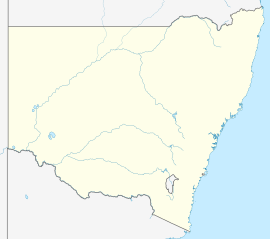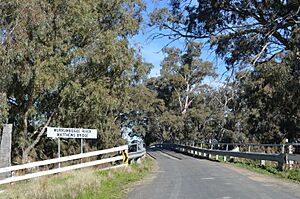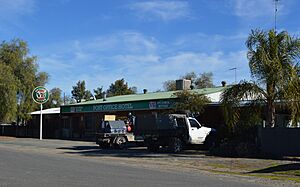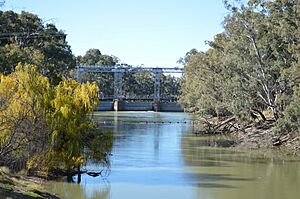Maude, New South Wales facts for kids
Quick facts for kids MaudeNew South Wales |
|
|---|---|

Yang Yang St, the main street of Maude
|
|
| Population | 161 (2006 census) |
| Established | 1861 |
| Postcode(s) | 2711 |
| Location | 55 km (34 mi) from Hay |
| LGA(s) | Hay Shire |
| County | Waradgery |
| State electorate(s) | Murray |
| Federal Division(s) | Farrer |
Maude is a small village located on the north side of the Murrumbidgee River in New South Wales, Australia. It sits between the towns of Hay and Balranald within the Hay Shire area. Maude is about 55 kilometres (34 miles) downstream from Hay. It is also 25 kilometres (15.5 miles) upstream from where the Lachlan River joins the Murrumbidgee.
In 2006, a census showed that 161 people lived in Maude. The village has a general store, a hotel, a post office, and a caravan park. Maude is surrounded by special farms called market gardens. These gardens get their water from the Maude Weir. The weir is a popular spot for people who enjoy fishing. They often catch fish like yellow belly, redfin, and Murray cod there.
Contents
Maude's History
Maude is a place with a long history. It marks the traditional meeting point for two Aboriginal groups: the Muthi Muthi and the Nari Nari tribes.
The "Pin Pan Pa" Reserve
Around 1849, a surveyor named F. P. McCabe mapped out several special areas along the Murrumbidgee River. These areas were officially set aside in 1852. One of them was the "Pin Pan Pa" reserve, which was about 7.5 square miles (19.4 square kilometres) in size. This reserve was located on land used by cattle farmers.
During the 1850s, the Pimpampa Reserve became a common place for moving livestock and wagons across the river. It was near where the Lachlan and Murrumbidgee rivers met. This made it a good spot for travelers who wanted to stay near water during hot, dry weather. Some records suggest a hotel might have been built here by the late 1850s. It was likely a simple, unofficial place for travelers and local workers to get drinks.
A New Town is Born
In the early 1860s, surveyors named Adams and Twynam planned a new town on the Pimpampa Reserve. They suggested the name 'Pimpaympa'. However, the government chose the name 'Maude' instead.
In April 1861, news spread that a new town called Maude had been planned. But some people worried about the new settlement. They thought it would be hard to reach during floods. Deep creeks surrounded the area, making it difficult to get to when the river was high. In fact, the area had been cut off by high water for about six months the previous year.
In late 1861, a large punt (a type of flat-bottomed boat used for crossing rivers) arrived at Maude. It was brought by a steamer called the Albury. Frank Johns and William Platt owned the punt. Frank Johns and his family moved to Maude and started operating the punt soon after it arrived.
Frank Johns, who was a carpenter, also began building a hotel in Maude. The hotel was finished in November 1862. Johns asked for a license to run the hotel. However, a local farmer and magistrate named Thomas D’Archy opposed it. He said there were no police in Maude. After a month's delay, Johns finally got his license for the Maude Punt Hotel. This was after he promised that police protection would be provided within three months.
By late 1862, plans were made to build a store in Maude. Many people also signed a petition asking the government to sell land in Maude. They wanted to settle there. Some people were confused by this, as the area could flood, and there wasn't much traffic. However, it was decided that the government should offer land for sale. This would give people a chance to settle and try to make their fortunes.
A post office opened in Maude on May 1, 1863. Henry Prendergast was likely the first postmaster. He and his son John had opened a store in the town. In October 1863, Maude was chosen as a place for holding small court sessions. Even by the end of 1863, the government still hadn't sold land in the town. This was despite many requests from residents. People living there were basically occupying Crown land without official permission.
In February 1864, Frank Johns gave his hotel license to Patrick Prendergast, another son of Henry. The Prendergast family built several stores in Maude, including a wool store. Wool from nearby farms was loaded onto steamers at Maude. These steamers then transported the wool, often to Echuca. By 1865, John Prendergast was the postmaster. Henry Prendergast passed away in January 1867, and his son John continued the family business.
Land in Maude was finally offered for sale on December 27, 1865. This was more than four years after the town was first planned. By then, many of the people who first wanted to buy land had already left the area.
Maude in the Late 1800s
From July 1, 1868, Daniel Murphy took over as the owner of the Maude Punt Hotel. In the same year, a second hotel opened in Maude called the Post Office Hotel. Patrick Prendergast was its first owner. The Maude Punt Hotel stopped operating by the early 1870s. This left the Post Office Hotel as the only hotel in Maude.
In early 1879, a visitor described Maude as a "little township" on the riverbank. It had four buildings, including a hotel, a store, and a police station. The hotel and store were both run by Mr. Daniel Murphy. The visitor also noted a punt crossing the river and a large wool store, both managed by Murphy. There was a lot of traffic crossing the river here. However, after heavy rains, it became very difficult to cross because the billabong (a type of waterhole) around the town became too deep.
Around May 1881, another visitor joked that Maude was "chiefly remarkable for its pigs." They said pigs were everywhere! This writer also mentioned that Maude had a store, a pub, a post office, a police barracks, a punt over the river, and even a talking cockatoo.
Maude Weir's Purpose
Between 1939 and 1940, a special structure called a weir was built on the river at Maude. The Murrumbidgee Irrigation Authority built it. The weir's main job was to send water onto the flood plain downstream. This helped make up for the lack of natural floods after the Burrinjuck Dam was built.
Recent Developments
In 1976, the village of Maude had about five houses. Public places included the Post Office Hotel (known as 'the Maude Pub'), a school, a sports oval, a service station, tennis courts, and a bridge over the Murrumbidgee River.
In 2020, work started to replace the old Matthews Bridge. A new concrete bridge is being built in its place.
Hells Gate Feedlot
Hells Gate is a large beef cattle feedlot located in the Maude area. It covers about 13,000 hectares (50 square miles) on the north side of the Sturt Highway. About 1,000 hectares (2,471 acres) of the property are used for irrigation. The Paterson family has owned this property since the 1960s.





